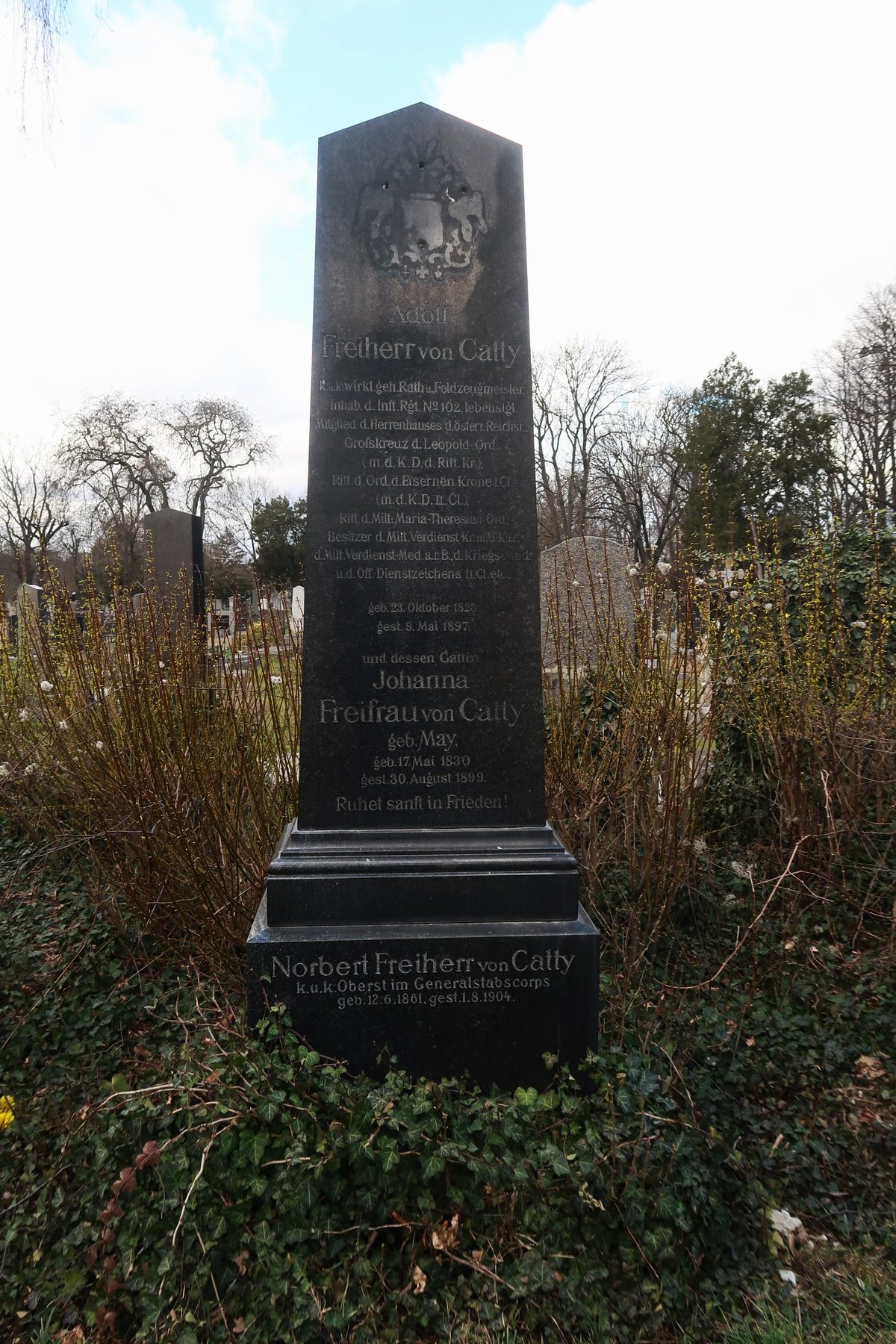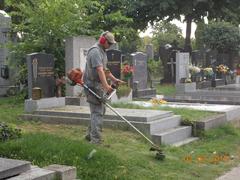
Vienna Central Cemetery: Visiting Hours, Tickets, Accessibility, and Guide to Vienna’s Historic Landmark
Date: 14/06/2025
Introduction
The Vienna Central Cemetery (Wiener Zentralfriedhof) is one of Europe’s largest and most culturally significant cemeteries—a true reflection of Vienna’s rich history, diverse population, and artistic legacy. Established in 1874 to serve the city’s growing and multi-faith communities, it now spans over 2.5 square kilometers and is the final resting place for more than three million people, including Austria’s most celebrated figures. With its blend of monumental architecture, lush parkland, and multicultural sections, the Zentralfriedhof is both a tranquil urban oasis and a living museum (vienna4u.at; SpottingHistory).
This comprehensive guide details the cemetery’s origins, cultural significance, practical visitor information (including visiting hours, ticketing, accessibility, and transport), highlights of notable graves and landmarks, and tips for making the most of your visit.
Table of Contents
- Origins and Historical Development
- Multicultural and Interdenominational Character
- Graves of Honour and Cultural Icons
- Architectural and Artistic Heritage
- The Cemetery as a Reflection of Vienna’s Social Fabric
- Practical Visitor Information
- Environmental Initiatives and Biodiversity
- FAQ
- Conclusion and Recommendations
- References and Further Reading
Origins and Historical Development
Opened on All Saints’ Day in 1874, the Vienna Central Cemetery was built to accommodate the city’s rapidly expanding population and the need for a modern, inclusive burial ground. The cemetery’s design drew on the 19th-century ideal of park-like cemeteries, featuring wide avenues, tree-lined paths, and a central axis culminating at the grand Karl-Borromäus-Kirche—a magnificent Art Nouveau church completed in 1911 by Max Hegele (fotoeins.com). From the outset, the cemetery was conceived as a multicultural and interdenominational space, reflecting Vienna’s diverse communities.
Multicultural and Interdenominational Character
Unlike many historic European cemeteries, the Zentralfriedhof was purposefully designed as an inclusive site. It features dedicated sections for Catholic, Protestant, Orthodox, Jewish, Muslim, Buddhist, Mormon, and other communities (vienna4u.at; allaboutvienna.com). The Jewish cemeteries—Old (accessible via Gate 1) and New (via Gate 4)—preserve Vienna’s Jewish heritage and are maintained by the Israelitische Kultusgemeinde Wien (jewishinvienna.com). The inclusion of Europe’s first Buddhist cemetery and dedicated Muslim and Mormon sections highlights the site’s ongoing commitment to religious and cultural diversity.
Graves of Honour and Cultural Icons
The cemetery’s Ehrengräber (Graves of Honour) are a major draw for visitors, commemorating Austria’s most influential figures from the worlds of music, politics, science, and the arts. The Musicians’ Corner (Group 32A) is particularly renowned, containing the graves of Beethoven, Brahms, Schubert, Strauss, Schoenberg, and a cenotaph for Mozart (vienna4u.at; Visiting Vienna; Wikipedia). Other honorary graves celebrate writers, artists, scientists, and modern icons such as pop star Falco and footballer Matthias Sindelar.
Architectural and Artistic Heritage
Central to the cemetery is the Karl-Borromäus-Kirche, an Art Nouveau (Jugendstil) masterpiece, with its striking dome and richly decorated interior (SpottingHistory). The surrounding grounds are a veritable open-air museum of funerary art, featuring everything from simple headstones to grand mausoleums, with styles ranging from Baroque to Modernist. Distinctive features include Hebrew inscriptions in the Jewish sections and unique Orthodox and Muslim gravestones.
The Cemetery as a Reflection of Vienna’s Social Fabric
Zentralfriedhof is more than a burial ground—it is a microcosm of Vienna’s evolving society. Its egalitarian layout juxtaposes the graves of the famous with those of everyday citizens, military personnel, and children, reflecting the city’s democratic ethos. The expansive, park-like setting is also a haven for urban wildlife, including deer, foxes, red squirrels, and numerous bird species (fotoeins.com; vienna-unwrapped.com).
Practical Visitor Information
Visiting Hours
- General Opening: Daily from 7:00 AM until sunset (typically 7:00 PM in summer; reduced hours in winter).
- Karl-Borromäus-Kirche: May have separate opening times, especially during events or concerts.
- Always check the official website or local tourism information for seasonal updates.
Tickets and Admission
- Entry: Free of charge for general visits.
- Guided Tours or Special Events: May require tickets; prices vary (public tours approximately €35 per person; private tours available).
- Horse-Drawn Carriage Tours: Depart daily from Gate 2, offering 30- or 60-minute rides; advance reservations recommended (Wien Info).
Accessibility
- Wheelchair Access: Main paths are flat and suitable for wheelchairs; some older and overgrown sections may be uneven.
- Accessible Facilities: Restrooms and information points at the main entrance.
- Mobility Services: Accessible public transport (trams 11 and 71 with low floors) and special vehicle access cards for visitors with mobility challenges (visitingvienna.com).
Getting There
- Public Transport:
- Tram 71 or 11 to “Zentralfriedhof 2. Tor” (main entrance).
- Tram 71 or 6 to “Zentralfriedhof 1. Tor” (Old Jewish Cemetery).
- By Car: Parking available near the main entrance, but public transport is preferred due to the cemetery’s size and environmental policies.
Maps and Navigation
- Free maps provided at main entrances and available online (vienna4u.at).
- On-site information boards, QR codes, and downloadable apps assist with navigation and highlight notable graves.
Visitor Etiquette
- Behave respectfully throughout, especially during funerals and in religious sections.
- Dress appropriately; modest clothing is recommended in Jewish, Muslim, and Orthodox areas.
- Photography is permitted for personal use, but avoid photographing mourners or ceremonies.
Guided Tours and Events
- Regular public and private tours focus on themes such as music, Jewish heritage, and art.
- Specialty tours like “The Secrets of the Central Cemetery” are available in several languages (secretvienna.org).
- The cemetery hosts cultural events, concerts, and exhibitions, especially in the Karl-Borromäus-Kirche and on All Saints’ Day.
Photographic Highlights
- The Art Nouveau Karl-Borromäus-Kirche, Musicians’ Corner, and the ornate honorary graves offer outstanding photo opportunities.
- Overgrown and wild sections provide atmospheric shots, especially in early morning or late afternoon light.
Environmental Initiatives and Biodiversity
The Zentralfriedhof is not just a cultural site—it is a key green space supporting urban biodiversity. The grounds host a variety of flora and fauna, from mature trees to wildflower meadows, and are intentionally managed to balance historical preservation with ecological stewardship (imp.ac.at). City initiatives foster native planting, create green corridors, and adapt to climate change with “Cooling Zones” and sustainable landscaping (anpedi.org).
Community engagement is encouraged through citizen science projects and educational programs about ecology and sustainability. Visitors are welcome to report wildlife sightings and join guided walks focused on the cemetery’s unique natural environment.
Frequently Asked Questions (FAQ)
Q: What are the Vienna Central Cemetery’s visiting hours?
A: Open daily from 7:00 AM to sunset; check for seasonal variations.
Q: Is there an entrance fee?
A: No, entry is free. Guided tours and special events may require tickets.
Q: Are guided tours available and accessible?
A: Yes, many tours are available and accessible to wheelchair users; confirm accessibility when booking.
Q: How do I get there by public transport?
A: Tram lines 11 and 71 serve the main entrances (“Zentralfriedhof 1. Tor” and “2. Tor”).
Q: Can I take photographs?
A: Yes, for personal use. Please be discreet and respect mourners.
Q: Are there facilities such as restrooms and cafés?
A: Yes, near the main entrance and at several points throughout the cemetery.
Conclusion and Recommendations
The Vienna Central Cemetery is more than a burial place—it is a vibrant, living archive of Vienna’s history, culture, and biodiversity. With free admission, generous opening hours, accessible paths, and easy public transport connections, it welcomes all visitors. Explore the cemetery’s rich mosaic of religious and artistic heritage, pay tribute to legendary figures in the Musicians’ Corner, and enjoy the serenity of its green spaces.
For the best experience, plan your visit in advance, download the Audiala app for guided tours, and check official sites for the latest information on opening hours and events. Whether you are a history enthusiast, music lover, or simply seeking a tranquil retreat, the Zentralfriedhof is a must-see among Vienna’s historic landmarks.
For more travel tips and updates, download the Audiala mobile app, follow our social media channels, and explore related posts on Vienna’s cultural landmarks.
References and Further Reading
- Vienna Central Cemetery: A Historical and Multicultural Marvel with Visitor Guide and Tips (vienna4u.at)
- Vienna Central Cemetery: Visiting Hours, Tickets, and Cultural Highlights (SpottingHistory)
- Visiting Vienna Central Cemetery: Honorary Graves, Visiting Hours, Tickets, and Historical Highlights (Visiting Vienna)
- Vienna Central Cemetery: Visiting Hours, Tickets, and History of Vienna’s Historic Cemetery (vienna-unwrapped.com)
- Beyond Death: The Vienna Central Cemetery as a Unique Cultural Venue (allaboutvienna.com)
- The Secrets of the Central Cemetery Tour (secretvienna.org)
- Enhancing Biodiversity at the Vienna Biocenter (imp.ac.at)
- Vienna’s Sustainability Efforts (anpedi.org)






















































































































































